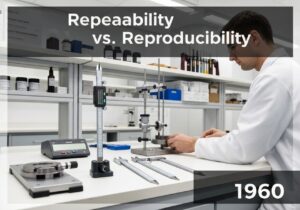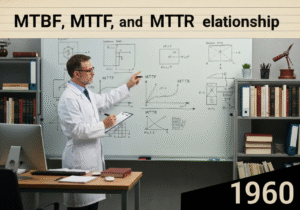Évaluer la quantité de variation dans un système de mesure qui est due à l'instrument de mesure lui-même (répétabilité) et aux opérateurs qui utilisent l'instrument (reproductibilité).
- Méthodologies : Ingénierie, Qualité
R&R des jauges (répétabilité et reproductibilité)

R&R des jauges (répétabilité et reproductibilité)
- Amélioration continue, Conception pour Six Sigma (DfSS), Capacité de traitement, Amélioration des processus, Assurance qualité, Contrôle de qualité, Statistical Analysis
Objectif :
Comment il est utilisé :
- Plusieurs opérateurs mesurent les mêmes pièces plusieurs fois à l'aide du même calibre. Une analyse statistique est ensuite effectuée pour déterminer le pourcentage de la variation totale du processus attribuable au système de mesure.
Avantages
- Permet de s'assurer que les données mesurées sont fiables et dignes de confiance ; identifie les sources d'erreur de mesure ; essentiel pour un contrôle efficace de la qualité des données. contrôle de processus et l'amélioration.
Inconvénients
- Peut prendre du temps pour être menée correctement ; nécessite une planification et une exécution minutieuses ; l'interprétation des résultats nécessite des connaissances statistiques.
Catégories :
- Lean Sigma, Fabrication, Qualité
Idéal pour :
- Évaluation de la précision et de la fiabilité d'un système de mesure.
Gage R&R studies are widely implemented across various industries such as manufacturing, automotive, aerospace, and healthcare, where consistent and accurate measurements are paramount for quality control and assurance. This methodology is particularly applicable during the early stages of product development, pilot production runs, and ongoing quality monitoring. Participants typically include quality engineers, process engineers, and operators who utilize measurement systems to assess critical dimensions and performance metrics of components. By conducting experiments where multiple operators measure the same parts using a designated gage under similar conditions, organizations can determine the extent of variability that can be attributed to the measurement system itself, as well as to operator variability. In automotive manufacturing, for instance, Gage R&R assessments help to ensure that measurements of component specifications align with safety and performance standards, thereby avoiding costly defects and recalls. Data obtained from statistical analysis enables teams to pinpoint specific sources of variability, whether they stem from equipment calibration issues or operator technique differences. This knowledge informs decisions regarding training needs for personnel, adjustments in measurement procedures, or enhancements in measurement equipment, thereby leading to more reliable processes. Regular application of Gage R&R studies can reinforce a company’s commitment to maintaining high-quality manufacturing standards and facilitate continual improvement initiatives within quality management systems such as ISO 9001 or Six Sigma methodologies.
Principales étapes de cette méthodologie
- Select measurement parts and ensure they represent the variation within the population.
- Train operators on the measurement procedure to maintain consistency.
- Have multiple operators measure the same parts multiple times using the same gage.
- Randomize the order of measurements to minimize bias.
- Calculate the variability components from the measurement data.
- Analyze the data using statistical methods, such as ANOVA or equivalent techniques.
- Determine the percentage of total process variation attributed to the measurement system.
- Evaluate and document whether the measurement system is adequate for the intended use.
- Identify and analyze sources of measurement error to improve the system.
Conseils de pro
- Utilize control charts to monitor and visualize variation over time and operator performance during the Gage R&R study.
- Incorporate training sessions for operators before conducting Gage R&R studies to ensure consistency in measurement techniques and interpretations.
- Perform a multidimensional analysis that includes factor interactions in your statistical evaluation to identify nuanced sources of measurement variation.
Lire et comparer plusieurs méthodologies, nous recommandons le
> Référentiel méthodologique étendu <
ainsi que plus de 400 autres méthodologies.
Vos commentaires sur cette méthodologie ou des informations supplémentaires sont les bienvenus sur le site web de la Commission européenne. section des commentaires ci-dessous ↓ , ainsi que toute idée ou lien en rapport avec l'ingénierie.
Contexte historique
1950
1950
1959-11
1960
1960
1960
1961
1950
1950
1950
1960
1960
1960
1960
1963
(si la date est inconnue ou n'est pas pertinente, par exemple "mécanique des fluides", une estimation arrondie de son émergence notable est fournie)














Articles Similaires
Gestion des opérations de fabrication (MOM)
Système d'exécution de la fabrication (MES)
Plan de contrôle de la fabrication
Tests manuels
Tableaux d'évaluation des manutentions manuelles (MAC)
ManTRA (outil d'évaluation des risques liés aux tâches manuelles)